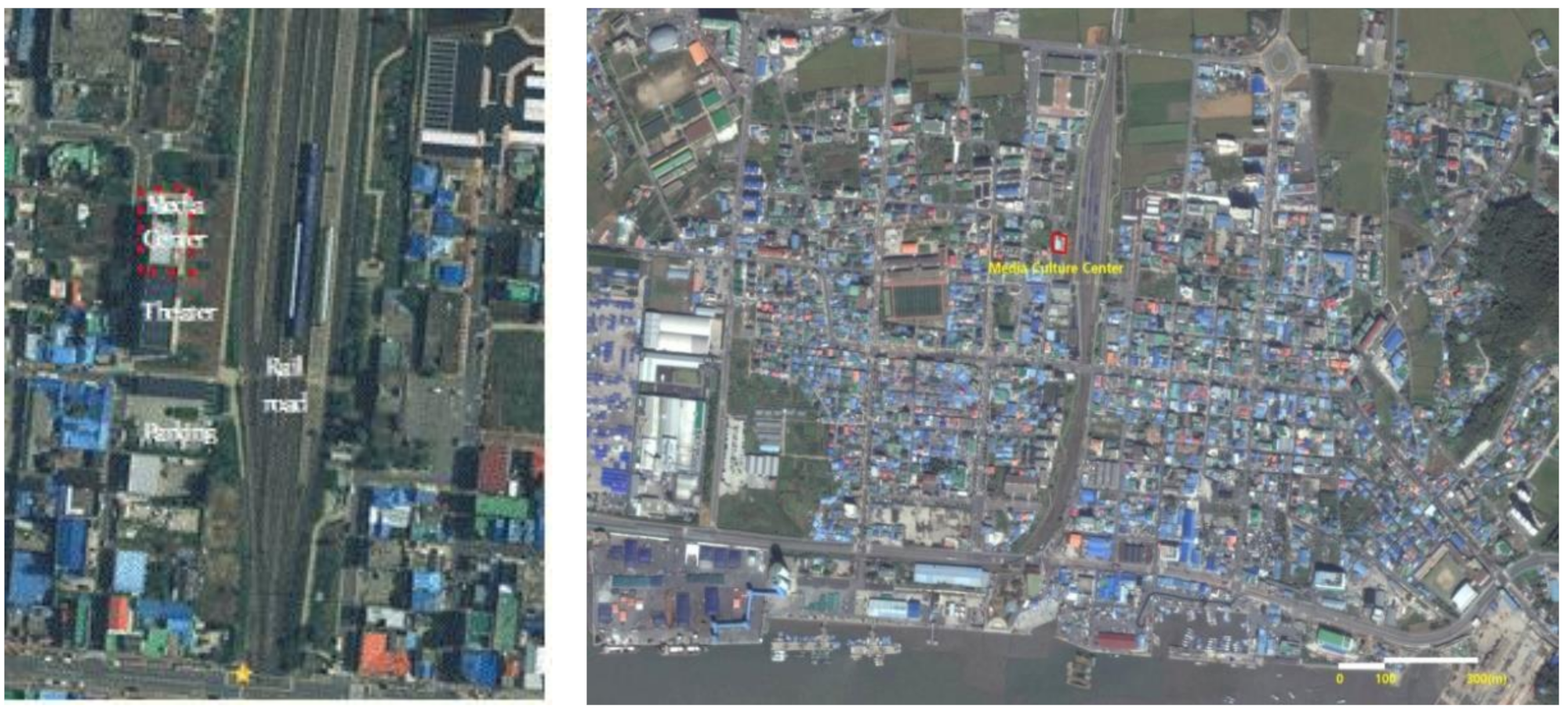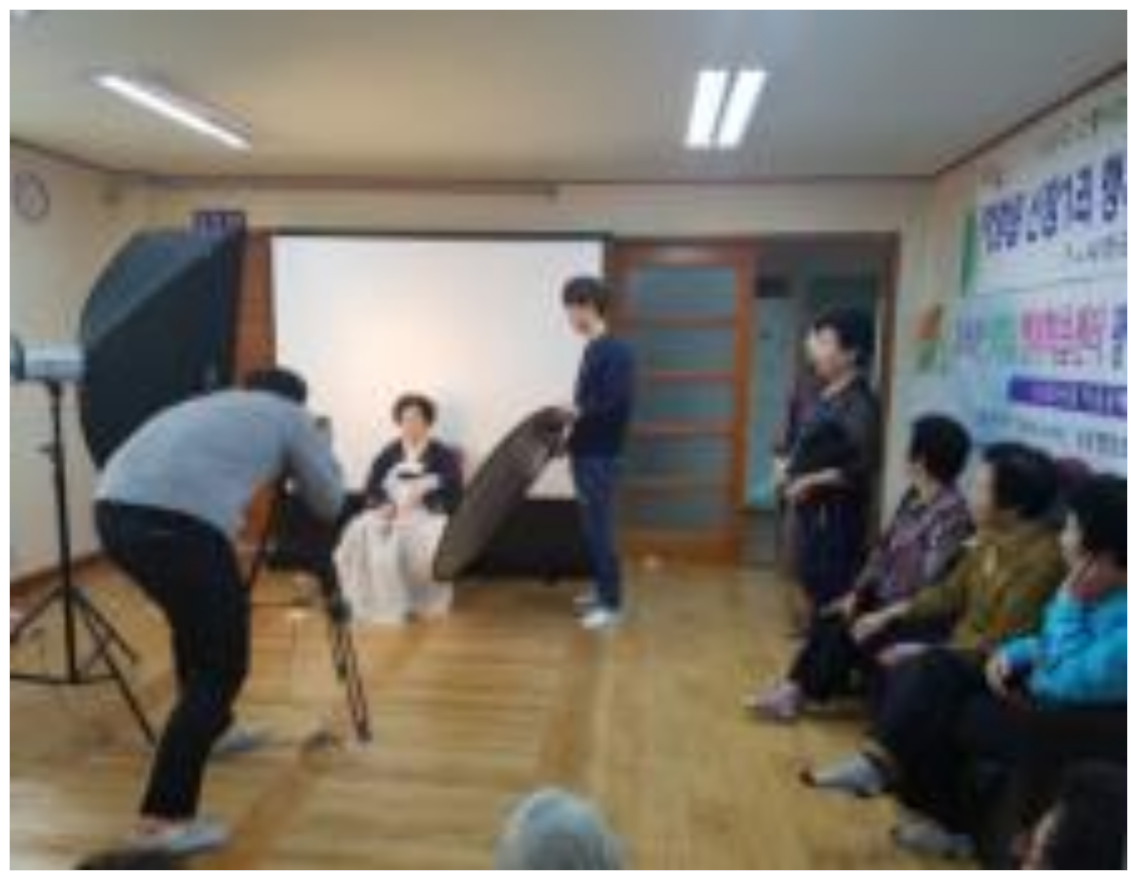Evaluating Ways to Form a Sense of Community in a Shrinking City: The Case of the Media Culture Center, Seocheon, South Korea
Abstract
1. Introduction
1.1. Study Background and Objective
1.2. Theoretical Review and Literature Review
1.2.1. Concept of the Shrinking City
1.2.2. Meaning and Utilization of Unused Spaces in a Shrinking City
1.2.3. Forming a Sense of Community
2. Materials and Methods
2.1. Study Subject
2.2. Methods
2.3. Data Collection Method
3. Results
3.1. Providing Services That Meet the Needs of the Region
“I don’t think we had enough time, experience, and ability to understand the local people. It could be different if we lived there, met the residents, made compromises, and made adjustments accordingly. It seems that it is necessary to have a local manager who can understand local politics and communicate with the residents.”—Interviewee A
“The aged like us do not go anywhere because it is difficult to move around, even though we are invited to an event. But it is so nice of them to visit us, take our pictures, show us movies, and talk with us. OO has become like a son to me. We visit each other and have meals together afterward.”—Interviewee H
3.2. Cultural Activities Performed Together
“I gained confidence and felt rewarded due to the fact that I could do something now. I feel a sense of belonging when I meet neighbors I have never met before and interact with them.”—Interviewee J
“Taking a photo has been my hobby since I was young, but I always took photos alone. I didn’t have many opportunities to meet people here, unlike Seoul. But, now, I’m so happy to go out with friends who have the same hobbies of taking photos, producing videos, and even submitting our works. I have become more attached to the village”.—Interviewee E
3.3. Accumulation of Local Assets and Formation of Local Governance
“Many old photos—even from the Late Period of Joseon—have been discovered. They are valuable cultural assets. The residents loved it when 700–800 photos were developed and exhibited at the town office. Since they were their own stories, they became very lively, sharing old memories with one another while enjoying the photos.”—Interviewee B
“When we finish the production of video and other materials, we send them all to the children of the elderly residents. Then, their families send us lengthy letters, rice cakes, and food, and call us from time to time.”—Interviewee G
“I did not know what this (the Media Culture Center) was for. I initially spoke badly about it, wondering why they were wasting the budget by establishing such a thing in the countryside. However, nowadays, it is not just me, but all the villagers say they work too hard; and we ask the county to raise their salary and budget.”—Interviewee L
4. Conclusions and Discussion
Funding
Institutional Review Board Statement
Informed Consent Statement
Data Availability Statement
Acknowledgments
Conflicts of Interest
References
- Hillery, G.H. Definition of community: Areas of agreement. Rural Sociol. 1955, 20, 12–24. [Google Scholar]
- Bernard, J. The Sociology of Community; Scott Foresman: Glenview, IL, USA, 1973. [Google Scholar]
- Kang, D.K. The change of community paradigm and construction of an unified conceptual system. J. Rural Soc. 2003, 13, 7–40. [Google Scholar]
- Oswalt, P.; Rieniets, T. Global Context. Shrinking Cities. 2007. Available online: http://www.shrinkingcities.com/globaler_kontext.0.html?&L=1 (accessed on 14 February 2021).
- Pallagst, K.; Aber, J.; Audirac, I.; Cunningham-Sabot, E.; Fol, S.; Martinez-Fernandez, C.; Moraes, S.; Mulligan, H.; Vargas-Hernandez, J.; Wiechmann, T.; et al. The Future of Shrinking Cities: Problems, Patterns and Strategies of Urban Transformation in a Global Context. 2009. Available online: https://escholarship.org/uc/item/7zz6s7bm (accessed on 14 February 2021).
- Newman, G.D.; Bowman, A.O.M.; Lee, J.R.; Kim, B.A. Current inventory of vacant urban land in America. J. Urban Des. 2016, 21, 302–319. [Google Scholar] [CrossRef]
- Park, J.G.; Kim, S.M. Demographic Changes and Regional Development Strategies by Local Government; Korea Research Institute for Local Administration: Wonju, Korea, 2017; pp. 13–15. [Google Scholar]
- Statistics Korea. 2015 Annual Population and Housing Census. Available online: http://kosis.kr/statisticsList/statisticsListIndex.do?menuId=M_01_01&vwcd=MT_ZTITLE&parmTabId=M_01_01 (accessed on 24 January 2021).
- Kim, W.Y. Resident participatory business seeing from the perspective of Eunpyeong-Gu’s Maeul Commmunity. Korean J. Public Soc. 2013, 3, 5–35. [Google Scholar]
- Kim, K.H.; Kim, Y. Urban decline and urban regeneration direction of local small and medium cities. Gyeongnam Dev. 2007, 89, 66–81. [Google Scholar]
- Lee, J.K. A study on activation methods of Old Downtown in Daegu: Concentrated on the practical use of unused school facilities. J. Educ. Environ. Res. 2011, 10, 64–73. [Google Scholar]
- Lee, H.; Han, S. Where Do Shrinking Cities Go from Here? Korea Research Institute for Human Settlements: Yanyang, Korea, 2014. [Google Scholar]
- Lee, J.M.; Lim, J.H. Case study on Humanity Community Building Project in the village of Eoro-ri, Chilgok-gun, Gyeongsangbuk-do. Korean J. Community Living Sci. 2016, 27, 593–608. [Google Scholar] [CrossRef]
- Park, S.H.; Kim, T.-Y.; Yeo, K.-H. A study on the formation of sense of community through Cultural Community Building Project: Focusing on the case of Seongnam’s’ ‘Making Our Neighborhood a Cultural Community’. J. Korean Reg. Dev. Assoc. 2013, 25, 207–229. [Google Scholar]
- Yoon, S. The case study of promoting regional community activities and supporting plans. J. Korean Soc. Wellness 2010, 5, 1–13. [Google Scholar]
- Kim, K.J. Causes and consequences of urban decline in Korean cities. Korean Urban Geogr. Soc. 2010, 13, 43–58. [Google Scholar]
- Ciesla, A. “Shrinking City” in Eastern Germany. The Term in the Context of Urban Development in Poland. 2013. Available online: https://www.db-thueringen.de/receive/dbt_mods_00036833 (accessed on 14 February 2021).
- Martinez-Fernandez, C.; Audirac, I.; Fol, S.; Cunningham-Sabot, E. Shrinking cities: Urban challenges of globalization. Int. J. Urban Reg. Res. 2012, 36, 213–225. [Google Scholar] [CrossRef] [PubMed]
- Laursen, L.L.H. Shrinking Cities or Urban Transformation; Institut for Arkitektur og Medieteknologi: Aalborg, Denmark, 2009. [Google Scholar]
- Pallagst, K. Shrinking cities: Planning challenges from an international perspective. In Cities Growing Smaller; Rugare, S., Schwarz, T., Eds.; Cleveland Urban Design Collaborative: Cleveland, OH, USA, 2008; pp. 6–16. [Google Scholar]
- Schilling, J.; Logan, J. Greening the rust belt: A green infrastructure model for right sizing America’s shrinking cities. J. Am. Plan. Assoc. 2008, 74, 451–466. [Google Scholar] [CrossRef]
- Hollstein, L.M. Planning Decision for Vacant Lots in the Context of Shrinking Cities: A Survey and Comparison of Practices in the United States. Ph.D. Thesis, University of Texas at Austin, Austin, TX, USA, 2014. [Google Scholar]
- Reckien, D.; Martinez-Fernandez, C. Why do cities shrink? Eur. Plan. Stud. 2011, 19, 1375–1397. [Google Scholar] [CrossRef]
- Heck, A.; Will, H. Interim use: Opportunity for new open-space quality in the inner city—The example of leipzig. Ger. J. Urban Stud. 2007, 46. [Google Scholar]
- Hollander, J.B.; Pallagst, K.; Schwarz, T.; Popper, F. Planning shrinking cities. Prog. Plan. 2009, 72, 223–232. [Google Scholar]
- Han, H.S. The impact of abandoned properties on nearby property values. Hous. Policy Debate 2014, 24, 311–334. [Google Scholar] [CrossRef]
- Spelman, W. Abandoned buildings: Magnets for crime? J. Crim. Just. 1993, 21, 481–495. [Google Scholar] [CrossRef]
- Stucky, T.D.; Ottensmann, J.R. Land use and violent crime? Criminology 2009, 47, 1223–1264. [Google Scholar] [CrossRef]
- Accordino, J.; Johnson, G.T. Addressing the vacant and abandoned property problem. J. Urban Aff. 2000, 22, 301–315. [Google Scholar] [CrossRef]
- PHS (Pennsylvania Horticultural Society). Available online: https://phsonline.org/programs/landcare-program (accessed on 14 February 2021).
- Glöckner, B.; Turn, T.L. Zwischennutzungen im Stadtumbau; PlanerIn: Berlin, Germany, 2004. [Google Scholar]
- Gstach, D. Temporary open spaces as incubator for social integration. Presented at the 45th International Making Cities Livable Conference, Portland, OR, USA, 10–14 June 2007. [Google Scholar]
- Lee, Y.J. A Strategic Plan of Urban Farming Garden Expo for the Vacant Space in Janghang, Seochun-gun, Chungcheongnam-do. Master’s Thesis, Seoul National University, Seoul, Korea, 2013. [Google Scholar]
- Lee, J.H. The environmental Design Using Unemployment Land of Old Jang-Hang Station. Master’s Thesis, Seoul National University, Seoul, Korea, 2008. [Google Scholar]
- Lee, J.W.; Sung, J.S. Conflicts of interest and change in original intent: A case study of vacant and abandoned homes repurposed as community gardens in a shrinking city, Daegu, South Korea. Sustainability 2017, 9, 2140. [Google Scholar] [CrossRef]
- Lee, J.W. Transforming unused spaces in a shrinking city through individuals’ spontaneous occupation activities: The case of Janghang, South Korea. Sustainability 2020, 12, 6621. [Google Scholar] [CrossRef]
- Lee, D.K.; Lee, H.Y.; Kwon, Y.S.; Jeon, E.C. Rediscovering the Vacant Land in the Era of Population Decline and Climate Change; Moonwoosa: Goyang, Korea, 2017. [Google Scholar]
- Burkholder, S. The new ecology of vacancy: Rethinking land use in shrinking cities. Sustainability 2012, 4, 1154–1172. [Google Scholar] [CrossRef]
- Heckert, M. Access and equity in greenspace provision: A comparison of methods to assess the impacts of greening vacant land. Trans. GIS 2013, 17, 808–827. [Google Scholar] [CrossRef]
- Heckert, M.; Mennis, J. The economic impact of greening urban vacant land: A spatial difference-in-differences analysis. Environ. Plan. A 2012, 44, 3010–3027. [Google Scholar] [CrossRef]
- Kaufman, D.A.; Cloutier, N.R. The impact of small brownfields and greenspaces on residential property values. J. Real Estate Finance Econ. 2006, 33, 19–30. [Google Scholar] [CrossRef]
- Kremer, P.; Hamstead, Z.A.; McPhearson, T. A social-ecological assessment of vacant lots in New York City. Landsc. Urban Plan. 2013, 120, 218–233. [Google Scholar] [CrossRef]
- Robinson, S.L.; Lundholm, J.T. Ecosystem services provided by urban spontaneous vegetation. Urban Ecosyst. 2012, 15, 545–557. [Google Scholar] [CrossRef]
- McMillan, D.W.; Chavis, D.M. Sense of community: A definition and theory. J. Community Psychol. 1986, 14, 6–23. [Google Scholar] [CrossRef]
- Long, D.A.; Perkins, D.D. Confirmatory factor analysis of the sense of community index and development of a brief sci. J. Community Psychol. 2003, 31, 279–296. [Google Scholar] [CrossRef]
- Park, J.G. Strategy on the formation of the regional community: Focus on the case of Cheonan. J. Korea Contents Assoc. 2012, 12, 183–193. [Google Scholar] [CrossRef]
- Janghang-eup. The History and Culture of Janghang; Janghang-eup: Seocheon, Korea, 2000. [Google Scholar]
- Daum Map. Available online: https://map.kakao.com (accessed on 24 February 2021).
- Seocheon Media Culture Center. Available online: https://www.media-center.or.kr/seocheon/main.do (accessed on 14 February 2021).
- Yin, R.K. Case Study Research: Design and Methods, 2nd ed.; Sage Publications: New York, NY, USA, 1994. [Google Scholar]
- Merriam, S.B. Qualitative Research and Case Study Application in Education; Jossey-Bass: San Francisco, CA, USA, 1998. [Google Scholar]
- Stake, R.E. Qualitative case studies. In The Sage Handbook of Qualitative Research; Denzin, N.K., Lincoln, Y.S., Eds.; Sage Publications Ltd.: London, UK, 2005; pp. 443–466. [Google Scholar]
- News Seocheon. Available online: www.newssc.co.kr (accessed on 14 February 2021).
- Sarzynski, A.; Vicino, T.J. Shrinking Suburbs: Analyzing the Decline of American Suburban Spaces. Sustainability 2019, 11, 5230. [Google Scholar] [CrossRef]




| Author | Definition |
|---|---|
| SCiRN Pallagst (2008) [21] | A city with a population of 10,000 or more that has experienced a population decrease for two years or more and economic transformation |
| Schilling and Logan (2008) [22] | An old industrial city that has lost 25% or more of its population over the past 40 years and, as a result, has more unused spaces such as houses, shopping centers, and factories |
| Reckien and Martinez-Fernandez (2011) [23] | A city that has experienced a population decrease, economic recession, and employment reduction over the past 40 and 50 years |
| Martinez-Fernandez et al. (2012) [18] | A city that has experienced a problem such as population decrease, economic recession, and employment reduction |
| Hollstein (2014) [22] | A city that has experienced a serious reduction in terms of population and economy while maintaining urban boundaries and infrastructure |
| Interviewee | Gender (Age) | Characteristic | ||
|---|---|---|---|---|
| 1 | Managers | A | Male (40s) | Initial manager |
| 2 | B | Male (60s) | Current manager | |
| 3 | Project planner | C | Male (50s) | - |
| 4 | Club participants | D | Male (30s) | - |
| 5 | E | Male (50s) | - | |
| 6 | F | Female (20s) | - | |
| 7 | G | Female (40s) | -- | |
| 8 | Residents | H | Male (80s) | - |
| 9 | I | Male (50s) | - | |
| 10 | J | Male (70s) | - | |
| 11 | K | Female (60s) | - | |
| 12 | L | Female (70s) | - | |
| Study Contents | Methods | Study Materials | |
|---|---|---|---|
| Literature review | Concept of a shrinking city Meaning and use of unused spaces in a shrinking city Sense of community | Literature review | Related domestic and international studies |
| ▼ | |||
| Site selection and status survey | Management process of Media Culture Center | Informal interview | Interview with related parties (managers, project planners, club participants, residents) |
| Field survey | Local newspapers and National Spatial Data Infrastructure Portal | ||
| Literature review | “Identification and promotion direction of projects related to urban regeneration in Janghang-eup”, “Report on Janghang Rural Center”, “Small Town Development Project Report”, and News Seocheon | ||
| ▼ | |||
| Data collection and analysis | Management of Media Culture Center and formation process of a community | In-depth interview | Interviews with related parties (managers, project planners, club participants, residents) |
| Target | Content |
|---|---|
| Managers | What were your primary objects in the management of the center? What did you do to build fellowship? |
| Club participants | What motivated you to participate in it? How did the participation activities affect your sense of community? |
| Residents | What do you think of the Media Culture Center? Does it affect the concord of the residents? If so, how? What other cultural activities will strengthen the meaning of the community and help you contribute (as volunteers) to the local people? |
| Planning Stage (2011) | 1st Management (2014–2016) | 2nd Management (2016–Current) | |
|---|---|---|---|
| Management Entity | Artist | Corporate K Community Radio | Non-profit corporation |
| Manager Characteristics | Resident artist | External experts | Local expert |
| Main Programs | Nightclub culture Media art Artist accommodation | Community radio Video club Media workshop | Visiting movie theater Visiting longevity photo Creating memories for the elderly Creating village memories Community radio Media workshop Video club |
| Program Goals | Culture production and consumption Inflow of outside population | Cultural enjoyment Enhancing a sense of community | Enhancing a sense of community Empowering cultural enjoyment Discovering and cumulating local assets |
| Program Characteristics | Residents and tourists visit | Spreading to residents | Visiting residents |
Publisher’s Note: MDPI stays neutral with regard to jurisdictional claims in published maps and institutional affiliations. |
© 2021 by the author. Licensee MDPI, Basel, Switzerland. This article is an open access article distributed under the terms and conditions of the Creative Commons Attribution (CC BY) license (https://creativecommons.org/licenses/by/4.0/).
Share and Cite
Lee, J.-W. Evaluating Ways to Form a Sense of Community in a Shrinking City: The Case of the Media Culture Center, Seocheon, South Korea. Sustainability 2021, 13, 3845. https://doi.org/10.3390/su13073845
Lee J-W. Evaluating Ways to Form a Sense of Community in a Shrinking City: The Case of the Media Culture Center, Seocheon, South Korea. Sustainability. 2021; 13(7):3845. https://doi.org/10.3390/su13073845
Chicago/Turabian StyleLee, Jin-Wook. 2021. "Evaluating Ways to Form a Sense of Community in a Shrinking City: The Case of the Media Culture Center, Seocheon, South Korea" Sustainability 13, no. 7: 3845. https://doi.org/10.3390/su13073845
APA StyleLee, J.-W. (2021). Evaluating Ways to Form a Sense of Community in a Shrinking City: The Case of the Media Culture Center, Seocheon, South Korea. Sustainability, 13(7), 3845. https://doi.org/10.3390/su13073845




